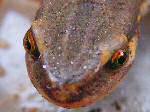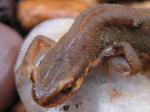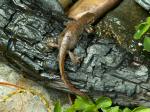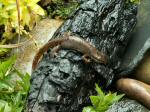| |
Newts |
We have three native species of newt here in the UK: Palmate Newt - Triturus helveticus / Lissotriton helveticus All of our newts hibernate during the winter months awaking in February
or March to return to ponds to breed. Outside of the spring breeding
season both Common and Palmate newts can be found far from water whilst
Great crested newts spend most of their time near water. For breeding,
weedy ponds without fish are favoured with the weeds providing cover
for the adults and the eggs being laid on the undersides of the leaves.
Once outside of the breeding season all three newt species are nocturnal,
hiding in damp environments during the day and hunting their prey of
aquatic and terrestrial invertebrates at night. They are useful in the
garden as their prey includes both slugs and snails. Common newts are
also known as smooth newts due to their smooth skins. Their bodies are
pale brown to olive green in colour and they have orange bellies. They
are generally covered in black spots including their throats. Palmate
newts are very similar but their throats do not have spots. Common and
Palmate newts are similarly sized, although Common newts are generally
slightly larger. Palmate newts may grow up to 4inches long including
their tails while common newts may reach 4.5 inches. Great-crested newts
are noticeably larger, reaching up to 7 inches in total length with
much larger and chunkier bodies than either the common or palmate newts.
They also have a warty skin; very dark with even darker spots and yellow
or orange undersides with black markings. The species gets its name
from the large, jagged crest the males develop during the breeding season.
Common newts are the most abundant newts in the United Kingdom and are
the only species of newts to be found in Ireland. Palmate newts have
more of a preference for shallow ponds on acidic soils. They are therefore
most common in areas where these conditions occur such as Devon and
Cornwall, Scotland and Wales where they can be more abundant than the
common newt. Great crested newts are far more rare and localised, although
quite widely distributed, particularly in England. All three newts are
protected under the Wildlife and Countryside Act 1981, prohibiting trade
in any of the three species. Great crested newts are quite rare due
to population declines, and they are heavily protected under law, making
it illegal to kill, injure, capture or disturb them; damage or destroy
their habitat; and to possess, sell or trade in them or even handle
them without a licence. They are a priority species under the UK Biodiversity
Action Plan, aiming to maintain, enhance and restore populations. |
 |
 |
 |
 |
 |
 |